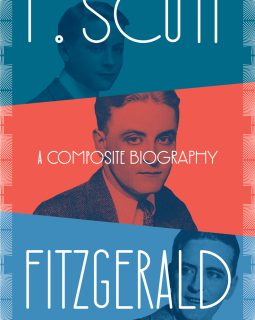F. Scott Fitzgerald: A Composite Biography

- Year
- 2024
- Creators
- Reviewed by Mark Taylor
- Topics
F. Scott Fitzgerald: A Composite Biography
Niklas Salmose and David Rennie, editors
Minneapolis, MN: University of Minnesota Press, 2024
448 pages; cloth/jacket, 78 b&w photos, $29.95
Author F. Scott Fitzgerald’s masterpiece The Great Gatsby is still selling 500,000 copies a year, nearly a century after its initial publication. And, Fitzgerald’s name is still synonymous with the decade he came to national prominence, as it conjures up the glitz and glamour of the 1920s “Jazz Age,” as he so memorably called it.[1]
Fitzgerald had deep ties to Ramsey County; he was born in St. Paul in 1896. Despite leaving the city in 1922, Fitzgerald continued to refer to Minnesota in his writings. Gatsby narrator Nick Carraway even name-checks prominent St. Paul families at the end of the book as he reminisces about train rides home from prep school.
There is still ample interest in Fitzgerald’s personal life, as well, and a new book— F. Scott Fitzgerald: A Composite Biography, published in July by University of Minnesota Press—takes a unique look at this Minnesota-born writer. Editors Niklas Salmose and David Rennie have split Fitzgerald’s forty-four-year lifespan into two-year periods, from 1896 to 1940. They then assembled twenty-three international Fitzgerald scholars to craft a chapter about Fitzgerald’s life during each period. The twenty-third chapter covers 1940, the last year of Fitzgerald’s life.
With over 400 pages, what is striking about the book is how much living Fitzgerald packed into his short life. Each contributor has a lot of ground to cover. Fitzgerald did not heed French novelist Gustave Flaubert’s advice, “Be regular and ordinary in your life, so that you may be violent and original in your work.” Just charting Scott and his wife Zelda’s peripatetic lifestyle necessitates a paragraph at the beginning of every chapter. Once Fitzgerald turned twenty, I could imagine biographers writing an entire book about nearly every two-year span of his dramatic life.
The contributors are an impressive list of scholars, including veteran Fitzgerald experts James L. W. West III and Jackson R. Bryer. Minnesota-based scholar David Page covers the pivotal years 1908 and 1909 when Fitzgerald moved back to St. Paul from upstate New York and began attending St. Paul Academy.
A Composite Biography also includes contributions from two scholars who passed away before the book went to press: Ronald Berman and Scott Donaldson. Donaldson, also a Minnesotan, was a perceptive biographer and critic of Fitzgerald, Ernest Hemingway, and John Cheever, among other writers.[2]
Befitting a writer who spent so many years abroad, there’s excellent representation in the book from foreign scholars as well: nine of the twenty-four contributors come from outside of the United States. It is fascinating to see how Fitzgerald’s life and works still speak to a global audience all these years later.
The chapters in A Composite Biography are all roughly similar in length. This has the effect of flattening some of the material. The years 1904 and 1905, when Fitzgerald turned eight and nine years old, are given the same space as the years 1924 and 1925, when Fitzgerald finished writing and editing The Great Gatsby. The premise of the biography means there’s no getting around this issue. It would defeat the purpose of the book if 1904 and 1905 were only given five pages while 1924 and 1925 got sixty.
Because of uniform chapter length, there is a lot of material about Fitzgerald’s early life, which should appeal to Minnesota Fitzgerald fans. His time in the state is not rushed but given the prominence it deserves. Helen Turner’s opening essay covering 1896 and 1897 is the finest writing I’ve read about Fitzgerald’s relationship with his parents and how it shaped him.
One of the more interesting chapters is Rennie’s, covering 1914 and 1915. He interprets Fitzgerald’s Princeton years through the lens of golf and country clubs, which were booming in the 1910s. Ramsey County residents will appreciate the sections about the White Bear Yacht Club and Town & Country Club.
One of my favorite quotes from the book related to Fitzgerald and St. Paul is from Walter Raubicheck, who writes of Scott and Zelda’s stay here between 1921 and 1922: “The St. Paul months gave Fitzgerald one last experience of his past, an experience that would remain a touchstone for the nostalgia that marks his best work.”[3]
The biography is surprisingly cohesive, despite being the product of so many different authors. The book will no doubt make you think about periods of Fitzgerald’s life you haven’t considered before. F. Scott Fitzgerald: A Composite Biography is ample proof that there is still much to be said about this important American author, more than eighty years after his death.
Mark Taylor is a writer and historian. The former social studies teacher gives F. Scott Fitzgerald tours and has lectured on Fitzgerald in St. Paul and at the 2023 International F. Scott Fitzgerald Society Conference in Sweden. He serves on the editorial board of the Ramsey County Historical Society. Taylor lives in St. Paul with his wife and two children.
NOTES
[1] F. Scott Fitzgerald, Tales of the Jazz Age (New York: Charles Scribner’s Sons, 1922); Charles Scribner III, Scribners: Five Generations in Publishing (Essex, CT: Lyons Press, 2023), 133.
[2] “Scott Donaldson, Biographer of Literary Titans, Dies at 92,” The New York Times, December 29, 2020, https://www.nytimes.com/2020/12/29/books/scott-donaldson-biographer-of-literary-titans-dies-at-92.html.
[3] Walter Raubicheck, quoted in Niklas Salmose and David Rennie, editors, F. Scott Fitzgerald: A Composite Biography (Minneapolis, MN: University of Minnesota Press, 2024), 210.
- Year
- 2024
- Creators
- Reviewed by Mark Taylor
- Topics